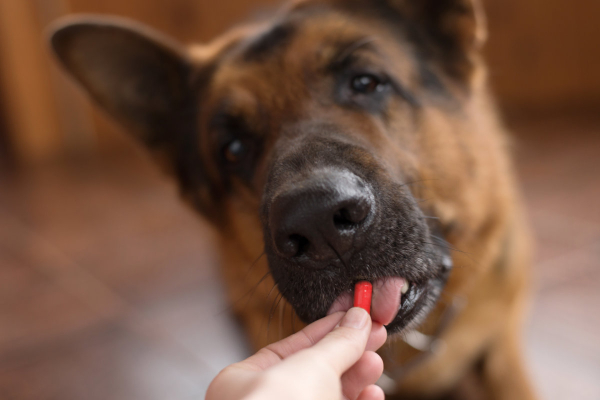Psychomotor seizures in dogs are a type of seizures in which the dog exhibits abnormal behaviors such as tail chasing, aggression, fear, or fly-biting. To help you recognize them, Dr. Leslie Gillette, friend of integrative veterinarian Dr. Julie Buzby, explains the symptoms, causes, diagnosis, treatment, and prognosis for psychomotor seizures in dogs.

My dad’s dog, Hoagie, had the unusual habit of aggressively chasing her tail whenever she became too excited. Her tail had been traumatically amputated before she came to live with my dad. Thus, we initially assumed that she was reacting to pain in the remaining tail stump.
However, as time passed, it was clear that Hoagie’s tail didn’t always “hurt.” Rather the aggression toward her tail became predictable when she was overstimulated. This led us to wonder if she was actually experiencing psychomotor seizures.
What are psychomotor seizures in dogs?
Psychomotor seizures in dogs are complex focal seizures or partial seizures during which the dog exhibits abnormal behaviors (e.g. fly-catching, tail chasing, unprovoked aggression, intense fear, etc.). They are triggered by abnormal electrical activity in a specific area of the brain.
Research shows that psychomotor seizures usually originate in the part of the brain known as the temporal lobe. Several structures within the temporal lobe, including the hypothalamus and amygdala, are part of the limbic system. The limbic system regulates emotion, sensation, learning, and memory.
Depending on the specific area and structure affected during a psychomotor seizure episode, the clinical signs a dog expresses can vary greatly. For example, seizure activity in the medial hypothalamus causes unprovoked aggression. If it is in the amygdala instead, the dog shows intense fear, and a sudden excessive appetite is tied to seizures affecting the lateral hypothalamus.
How do you know if it is a psychomotor seizure or just an odd behavior?
Some behaviors may simply be a one-off episode in a neurologically normal dog. However, dogs with psychomotor seizures predictably exhibit the same aberrant behaviors during each episode. They also may seem unaware of what they are doing or start to act abnormally (whining, pacing, acting like they know something is “wrong”) prior to the seizure. Depending on the underlying cause, psychomotor seizures may also progress to generalized seizures.
Generalized seizures (grand mal seizures in dogs) affect the transmission of electrical impulses to the entire brain. This is the “classic” type of seizure, and consists of full-body involvement with limb stiffness followed by convulsive muscle twitching and loss of consciousness. Then the dog may be disoriented and exhausted once the active seizure has subsided.
When do psychomotor seizures tend to start?
Psychomotor seizures usually develop before two years of age. Often the first one occurs during puberty (around 8-10 months of age) in conjunction with hormone fluctuations. However, they have been identified in certain breeds, like the Boerboel, as young as three months old.
What are the causes of psychomotor seizures in dogs?
Many studies have attempted to identify the primary cause of psychomotor seizures in dogs. Some researchers have even suggested that these episodes are not actual seizures at all. Instead they postulate the behaviors occur due to poor or abnormal vision (in the case of star gazing and fly-biting) or as manifestations of obsessive-compulsive disorders (e.g. tail chasing or circling).
Breed (Primary epilepsy)
However, studies of specific breeds do point to psychomotor seizure activity as a primary form of epilepsy in dogs that is based in the temporal lobe and carries a familial link. German Shepherds, Beagles, and Bernese Mountain Dogs are all identified as breeds with a genetic predisposition to seizure activity from idiopathic epilepsy.

Two interesting examples of breed-specific studies I’ll share here include Bull Terriers (think Spot from Target) and Boerboels (South African Mastiffs).
Bull terriers have psychomotor seizures due to congenital hydrocephalus
Bull Terriers are prone to hydrocephalus, or “water on the brain,” a condition that occurs when a dog has too much cerebrospinal fluid. Hydrocephalus can increase the pressure inside the skull and enlarge specific structures within the cerebrum.
As a result, many Bull Terrier parents have reported witnessing their dogs in the throes of extreme fear, unprovoked aggression, tail chasing, hyperexcitability, and hypersensitivity to sound—in other words, psychomotor seizures.
Boerboels have hereditary psychomotor seizures
Boerboel dogs also have an increased risk of hereditary issues, including heart disease in dogs and hip dysplasia in dogs. Interestingly, a 2018 study identified fear-based psychomotor seizures in several Boerboel pups from a litter in the Netherlands.
The affected pups began showing signs of abnormal behavior in the form of severe panic attacks, fearful facial expressions, and freezing or cowering in the absence of any real threat. These signs often coincided with being startled awake and started as early as three months of age.
Diagnostic testing led researchers to conclude that the psychomotor seizure signs in this litter were due to an autosomal recessive genetic disorder. In other words, both parents also carried the abnormal gene.
Secondary causes of seizures
Psychomotor seizures may also be associated with secondary epilepsy in dogs. This means some other ailment or insult is responsible for the onset of signs. Potential causes may include:
- Toxins—pesticides, chemicals such as antifreeze, prescription medications, illicit drugs, some house or yard plants, foods such as chocolate, alcohol, or xylitol/birch sugar (a popular sugar substitute)
- Infections—distemper, rabies
- Inflammation—granulomatous meningoencephalitis (GME in dogs)
- Metabolic disorders—liver disease in dogs, kidney disease in dogs, electrolyte imbalances, blood sugar abnormalities (low or high)
- Nutritional issues—excessive salt intake
- Trauma—brain damage from dog fights, neonatal injury, being hit by car, etc.
- Degenerative diseases—canine cognitive dysfunction (doggy dementia)
- Tumors or cysts—brain tumors in dogs (both benign and malignant tumors can be problematic), or anything else that takes up space in the cranium and puts pressure on the brain
- Vascular disorders—strokes, clotting disorders

What are the symptoms of psychomotor seizures in dogs?
The symptoms of psychomotor seizures vary widely depending on the specific area of the brain that is affected. Dog parents most commonly report the following symptoms:
Pre-ictal (pre-seizure) behavior changes
In the minutes to hours that precede a seizure episode (pre-ictal period), dogs may transition from normal activity to a state of depression. And some may become uncharacteristically irritable with no provocation.
Hallucinations or altered state of consciousness
Dogs in the midst of a psychomotor seizure episode may experience altered mental status and seem unaware of what they are doing. However, they don’t completely lose consciousness.
Unprovoked rage or aggression
This rage or aggression that comes out of nowhere is known as “Cocker rage.” But may actually include other breeds like Springer Spaniels, Bull Terriers, and Retrievers too. Psychomotor episodes may occur days or weeks apart, which helps differentiate it from behavioral conflict aggression. Additionally, rage episodes tend to last longer than conflict aggression episodes.
Extreme fearfulness
Affected dogs may suddenly exhibit extreme fear in the face of no actual threat. These behaviors may include flinching, vocalizing, cowering in a corner, and running frantically away from nothing. Sometimes they will experience fear to the point that they may urinate, defecate, and express their anal glands.
Star gazing
During the psychomotor seizure, the dog may be staring into space as though in a trance. Or the dog might stare into the sky.
Fly-biting
The dog may appear to be snapping at imaginary flies. This may be related to abnormal predatory behavior. Alternatively, some researchers believe it could be related to visual abnormalities rather than being a neurological problem.
Obsessive repetitive behavior
Dogs may engage in repetitive behaviors such as tail chasing, flank biting, or the dog keeps walking in circles. It can be challenging sometimes to determine if the behavior is due to a seizure, anxiety, or compulsive disorder.
Abnormal fits of chewing, licking, swallowing, or eating objects
The dog may stare into space and swallow, gulp, lick the floor, or lick their lips. Sometimes affected dogs will also eat foreign material such as rocks, hair, dirt, or flooring.

Change in bodily functions
Less common signs may include spontaneous urination, defecation, and release of anal glands. Or you might notice a sudden extreme increase in water or food intake.
Behavior changes during the post-ictal (post-seizure) period
Once the psychomotor seizure is over, the dog may exhibit aggression, depression, or exhaustion.
How will the vet diagnose a dog with psychomotor seizures?
If you are concerned that your dog is experiencing seizure activity at home, schedule an appointment with your veterinarian. If possible, record a short video clip of your dog during an episode. Then share it with your veterinarian at your appointment.
After gathering the history and getting an idea of what the episodes are like, your veterinarian will perform a complete physical and neurological examination. Then he or she will likely recommend additional testing.
Psychomotor seizures are often considered a “diagnosis of exclusion.” Thus, the goal of diagnostic testing is to rule out all other possible causes of the behavior.
Potential tests include:
- Blood tests — The vet may run blood tests for dogs such as a CBC, chemistry panel (with electrolytes), thyroid testing, and cortisol levels. These baseline tests will help your veterinarian identify any underlying issues such as infection, inflammation, cancer, or metabolic disorders that could contribute to your dog’s symptoms.
- MRI/CT scans—A veterinary neurologist usually performs these tests at a specialty clinic. He or she will sedate your dog and administer a contrast medium through an IV. This can help identify structural or vascular abnormalities in the nervous system.
- CSF (cerebrospinal fluid) tap—This procedure is usually conducted under a light plane of sedation to avoid accidental injury to the spinal cord during sample collection. A CSF tap can help rule out infectious or inflammatory conditions.
- Electroencephalogram (EEG)—An EEG, which assesses electrical activity in the brain, is probably the best diagnostic tool for identifying seizure activity. The drawback is that it is ideal to run the EEG and collect data mid-seizure, which is virtually impossible.
What is the treatment for psychomotor seizures?
Once your vet diagnoses your dog with psychomotor seizures, he or she will work with you to formulate a treatment plan.
Monitoring the seizures
The good news is that your dog may not need anti-seizure medication if his or her episodes are mild, infrequent, and do not involve aggressive behavior. To track the frequency and severity of the seizures, it can be helpful to keep a seizure diary. Then you can share it with your veterinarian at each visit.

Plus, it is a good idea to take note of any potential seizure triggers. Some examples include excitation at mealtime, visitors knocking or ringing the doorbell, construction, fireworks or other loud noises, barometric pressure changes, lunar phase, sleep disturbances, or other stressors unique to your dog.
Anti-seizure medications
In the event your dog does require medication, there are several options available to mitigate seizure activity. First-line medications may include phenobarbital, potassium bromide, zonisamide for dogs, or levetiracetam. For example, there is a case report where phenobarbital decreased episodic rage in dogs.
Some veterinarians will also recommend SSRIs (selective serotonin reuptake inhibitors) like ClomicalmⓇ (clomipramine) if the first-line therapies don’t achieve adequate seizure control.
Dietary therapy
Dietary therapy is also an option for dogs with seizures. Research has shown that good gut health is critical for reducing inflammation within the body and improving brain function. Thus, offering a life-stage-appropriate, nutritionally balanced diet is important for your dog’s seizure journey.
Sometimes this may involve using prescription brain health diets such as Purina Proplan NeuroCare® or Hill’s Prescription Diet® b/d.
MCT oil supplements
Health supplements like Dr. Buzby’s Brain Boost™ organic MCT oil for dogs, formulated with medium-chain triglycerides (MCTs), can also help manage seizures. Among other things, one of the benefits of MCT oil for dogs is that it increases the seizure threshold (the amount of abnormal brain activity it takes to cause a seizure). This helps decrease the frequency and severity of seizures.
However, it is important to remember that MCT oil complements, rather than replaces, traditional anti-convulsant therapy.
Traditional Chinese Veterinary Medicine (TCVM)
Traditional Chinese Veterinary Medicine (TCVM) practices, including acupuncture for dogs, herbal supplements, and tui-na (therapeutic massage), have also shown promising results as part of a multi-pronged approach to seizure management.

Treating the underlying problem
If the vet does diagnose your dog with a brain tumor, metabolic disease, or other condition, or if the seizures are a result of a toxicity, the vet will also take steps to address the underlying problem.
Creating a safety plan if your dog becomes aggressive during or after seizures
It is important to take psychomotor seizures that manifest as unprovoked rage or aggression very seriously. While he or she doesn’t mean to, your dog could seriously injure you, a family member, or another pet during the episode. Work with your veterinarian or a veterinary specialist to determine what is best for your dog and safest for your family.
What is the long-term prognosis for dogs with psychomotor seizures?
Thankfully, the long-term prognosis for dogs with psychomotor seizures is good. Most dogs can enjoy a normal lifespan, even those who require medical management. However, seizures due to a mass in the brain or other serious medical condition carry a worse prognosis due to the effects of the underlying problem.
As with other seizure types, immediately make an emergency vet visit if your dog experiences a seizure episode that lasts more than five minutes or if two or more episodes (cluster seizures) occur within 24 hours.
Is it possible to prevent future seizures?
In most cases, there is no surefire way to prevent the onset of a seizure. However, these tips can help decrease them:
- If you can identify specific triggers for your dog, take steps to minimize or eliminate these whenever possible.
- Stay consistent in your dog’s daily medication dosing if your veterinarian has recommended antiepileptic or anxiolytic medications.
- Schedule regular follow-up visits with your veterinarian. This will also allow you to be proactive in your dog’s continued care, especially if breakthrough seizure activity or other adverse symptoms develop.

Hope for dogs with psychomotor seizures
Remember my dad’s dog? The veterinarian ultimately recommended starting her on anti-anxiety medication to help ease the urge to chase her tail. Still, it was a behavior she continued to exhibit periodically throughout her life. In retrospect, I do believe Hoagie was likely experiencing psychomotor seizures. However, they never kept her from living a wonderful life with my dad.
The same can be true of your dog too. If he or she is exhibiting abnormal behaviors and you don’t know if they are psychomotor seizure or something else, reach out to your veterinarian. He or she would be happy to help you get to the bottom of whatever is going on with your dog so you and your dog can keep on living life to the fullest together.
If your dog had psychomotor seizures, what did they look like?
Please comment below.

